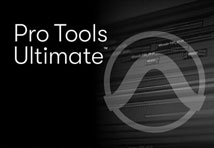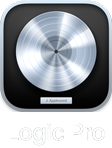Frequently Asked Questions
- 1. What is Dolby Atmos Music?
- 2. Why mix in Dolby Atmos Music?
- 3. What is the Dolby Atmos Music 9.1.6 speaker setup in the Control Room?
- 4. Which genres of music are welcome at Delta Music Belgium?
- 5. Which files can be processed?
- 6. How to deliver or get files delivered?
- 7. Which musical ensembles can be recorded?
- 8. Is it possible to record acoustic drums?
- 9. Can I order 1000 CDs or 200 vinyl records?
- 10. How does Delta Music Belgium deal with your privacy?
- 11. What is the name of the flower in the logo of Delta Music Belgium?
![]()
1. What is Dolby Atmos Music?
![]()
Standard Dolby Atmos was originally created as the next generation format for cinema sound, designed, based on feedback from film re-recording mixers. Following widespread theatrical adoption, this technology has filtered down into the home cinema environment for both film and TV content spanning drama, documentary, and live events. Dolby Atmos is offered in many countries through traditional TV broadcasts, as well as through online streaming services such as Netflix, Amazon Prime Video and Apple TV+.
Dolby Atmos Music is a revolutionary new 'object-based' audio format for music production. This new format allows artists to push their creative boundaries. With Dolby Atmos Music, mixers have the ability to place and move sounds in a 3D environment with more precision, opening up even more creative possibilities. Music producers can now create songs that make listeners feel like they are in their favorite music.
Technically, Dolby Atmos and Dolby Atmos Music are a logical progression from Dolby Surround 5.1 with more speakers around you and also speakers above your head for a more immersive listening experience, hence the term 'immersive audio' because immersive comes from 'immersion' and that is exactly what happens because you are immersed in sound with Dolby Atmos Music.
Dolby Atmos Music is listened to via online music streaming services such as Apple Music, Amazon Music Unlimited or TIDAL HiFi, but undoubtedly other music streaming services will follow. You can also find Dolby Atmos Music mixes on Blu-ray, such as live concerts and special anniversary editions of well-known albums that were remixed in Dolby Atmos Music.
![]()
2. Why mix in Dolby Atmos Music?
![]()
First and foremost, it is a lot of fun to mix in Dolby Atmos Music because you literally have a complete 3D space around you in which you can place musical instruments or sound effects wherever you want. One step further is that you can also make those musical instruments or sound effects move around in the same 3D space. After so many years of mixing in stereo and occasionally in surround 5.1, mixing has now become a very creative process again. For example, you can remain very conservative and true to nature and just make a stereo mix a bit wider, higher and deeper. But you can also explore the boundaries of what is possible and create very experimental Dolby Atmos Music mixes that no longer have a direct connection with the reality of musicians making music in a room. This opens up virtually unlimited possibilities, especially for electronic music genres, but also for avant-garde music, for example.
For new music productions, it is increasingly common to offer a Dolby Atmos Music mix in addition to a stereo mix. Nowadays, Apple Music even asks to provide a Dolby Atmos Music mix as standard, with or without a separate stereo mix. Otherwise, for stereo playback, the Dolby Atmos Music mix will automatically be reduced to a stereo mix over which you as a music producer or artist have (had) no control. But other music streaming services will undoubtedly follow suit and start demanding Dolby Atmos Music mixes because Dolby Atmos Music is becoming increasingly common.
For older music productions that are being re-released, a Dolby Atmos Music mix is now also recommended or required. The cheapest option is to upmix the original stereo mix to Dolby Atmos Music via algorithms in a plugin, but the result is rarely good. If you have access to the original multi-track recordings or submixes of all instrument groups separately, then it is much better to rebuild the Dolby Atmos Music mix from scratch.
FYI: Many people listen and mix Dolby Atmos Music on headphones via binaural stereo or Apple Spatial Audio. This works to a certain extent, but you will never be able to experience what a Dolby Atmos Music mix really sounds like in a listening room. It is therefore highly recommended that you listen to your Dolby Atmos Music mixes with a real Dolby Atmos Music 9.1.6 speaker setup that is correctly placed and calibrated. Actually moving air in a listening room with speakers is always better than having to rely on the on the tiny puffs in headphones :-) Although this is of course mainly about checking the acoustic phase coherence of the music in the listening room because this is very difficult to check with headphones and can be done much much better with a real Dolby Atmos Music 9.1.6 speaker setup as described below.
![]()
3. What is the Dolby Atmos Music 9.1.6 speaker setup in the Control Room?
![]()
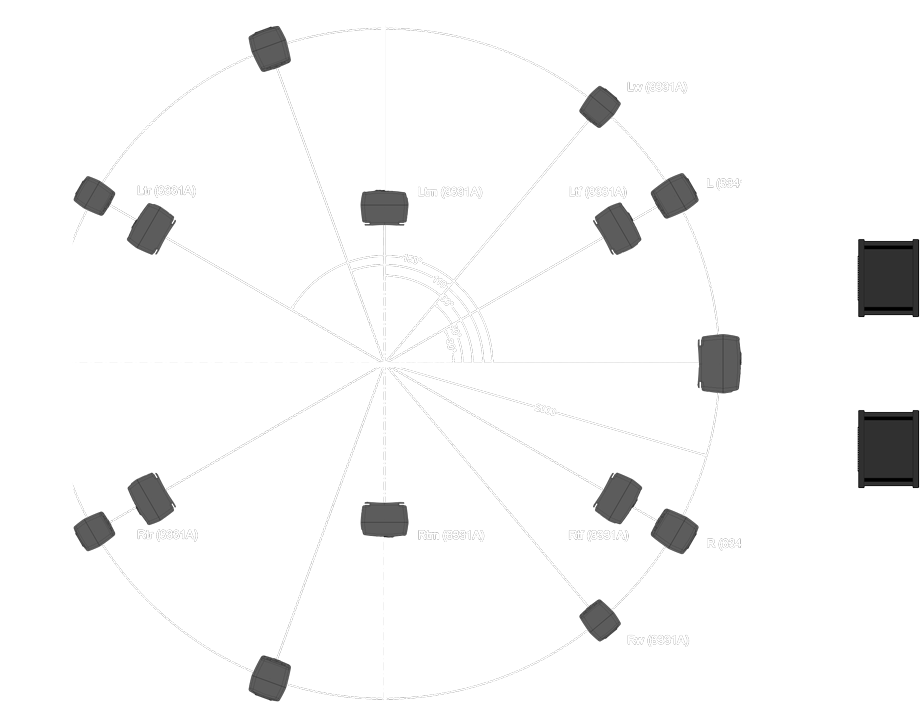
The speaker setup in the Control Room is designed for Dolby Atmos Music 9.1.6 format and Apple's Spatial Audio format on Apple Music (which is the same). It is an 'equidistant' layout in which all speakers are placed or hung at an equal distance from the center of the circle (the listening point).
On the construction plan below you can see even better where exactly the speakers are located in the Control Room:
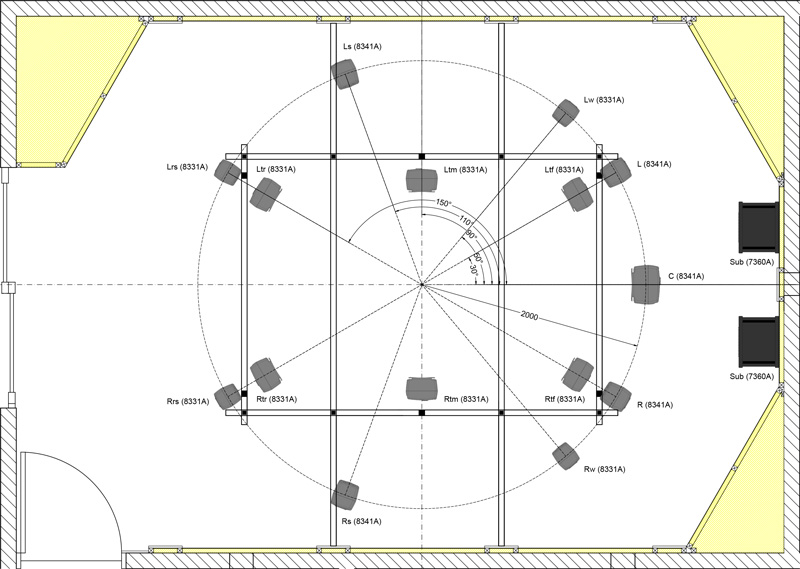
Only the Ltm (Left top middle) and Rtm (Right top middle) are slightly closer, but this is compensated by the AutoCal 2 calibration by the Genelec Loudspeaker Manager (GLM) software. AutoCal 2 provides level adjustments, distance delays, subwoofer crossover phase correction, and room response compensation equalization. So you are actually listening within a hemisphere with all speakers located on the edge of the sphere.
The result is that all sound from all speakers is acoustically phase coherent and therefore arrives at the listening point at the same time, which is very important when mixing music correctly + all Genelec 'The Ones' speakers are designed as point sources, resulting in a very high definition of the virtual sound sources within the listening room.
Of course, with this speaker setup you can also mix sound for movies in the standard Dolby Atmos format with this speaker setup, but with a standard standard Dolby Atmos speaker setup, the speakers are not equidistant from the listening point. Because standard Dolby Atmos uses an orthogonal speaker arrangement, the front speakers hang behind the movie screen on the front wall, the other surround speakers hang on the side walls and on the rear wall and the height speakers hang from the ceiling. Logically, with such an orthogonal loudspeaker arrangement, the sound from all loudspeakers cannot arrive at the listening point in an acoustically phase coherent manner.
But for mixing sound for movies, acoustic phase coherence is not necessary at all, because almost all sound in a film are point sources (e.g. voices and sound effects) and 'sound beds' (atmospheric sounds, street sounds, the reverberation in a room). , etc...). And the music in a movie is usually a standard stereo mix that sounds from the front and/or back and is static. In films where music takes a more prominent place, the music can sometimes be a surround 5.1 mix or even a Dolby Atmos Music mix. But this is still rather exceptional because in a cinema or home cinema with a standard orthogonal Dolby Atmos speaker setup, the music will sound strange anyway, with, for example, many problems related to the acoustic phase coherence of the sound and therefore will have little definition.
In summary, you can easily mix the sound for movies with a Dolby Atmos Music 9.1.6 speaker setup, but you can never properly mix music with a standard Dolby Atmos speaker setup.
![]()
4. Which genres of music are welcome at Delta Music Belgium?
![]()
In principle, all genres are welcome, because in every genre there is good music to be found. But at the same time there is hardly anything less pleasant than doing a music production when you do not like the music. For that reason I always ask to hear the music in advance. This can be a live recording of a concert or a rudimental demo recording in the rehearsal room. These days almost every smart phone can record sound and such a recording is good enough to get an idea about the genre of music and the musical abilities. If I don’t like the music (which is a personal taste), then I will say this in advance and I will refer the client to a colleague.
Of course I have my own musical preferences, I grew up in the 80s, so I like New Wave, Cold Wave and EBM very much (I still wear black clothes and I wear 8 silver rings). More recently I like trip hop and the more experimental or harder rock bands. I'm also a big fan of almost all music that is Belgian, almost the whole world knows that there is very good and innovative music that is being made over here.
In the field of classical music, I have a weakness for the French impressionism of Eric Satie, Claude Debussy, Maurice Ravel and Gabriel Fauré. I also find contemporary classical music very interesting, especially experimental and advantgardistic music.
And since my first experiences with music productions were the big theatrical musicals, I still have a weakness for that too.
But my biggest inspiration and personal all time favourite is without any doubt the Greek composer Evanghelos Odysseas Papathanassiou also known as Vangelis.
This is a list of my favorite artists and groups (besides Vangelis) in alphabetical order:
|
|
|
As a summary, you could say that I have a strong preference for alternative and innovative music.
What I do not really appreciate are the following music genres:
- the commercial EDM and the accompanying DJ culture that is out of all proportion
- Flemish and Dutch schlager and carnival music, although I am a big fan of the productions of Marco Borsato
- everything that has to do with commercial advertising, so no advertising spots, unless it is for non-commercial purposes
- everything that has a religious background, because by definition this does not fit into my world view
In any case, every piece of music that is sent to me I take into consideration
![]()
5. Which files can be processed?
![]()
Pro Tools Ultimate
Pro Tools Ultimate is the primary DAW for mixing and mastering audio, Pro Tools Ultimate reads the following Pro Tools session files:
.pts
- Pro Tools 5 (1999-2003)
- Pro Tools 6 (2003-2005)
.ptf
- Pro Tools 7 (2005-2008)
- Pro Tools 8 (2009-2010)
- Pro Tools 9 (2010-2011)
.ptx
- Pro Tools 10 (2011) tot heden
Pro Tools Ultimate can import and export the following types of audio files without converting them:
.aif / .aiff
- PCM (uncompressed) audio
.mxf
- PC (uncompressed) audio
- OP-Atom (single audio channel per file)
.wav
- PCM (uncompressed) audio
- RF64, BW64 (audio data only), OMF
Pro Tools Ultimate can import the following types of audio files with conversion to the format used in the Pro Tools session:
.aif / .aiff
- PCM (uncompressed) audio
.mxf
- PC (uncompressed) audio
- OP-Atom (single audio channel per file)
.m4a / .m4v / .mp4 / .aac
- AAC audio
- Apple Lossless ALAC
.mp3
- MP3 audio
.mov
- PCM (uncompressed)
- AAC audio
- Apple Lossless ALAC
.mxf
- PCM (uncompressed) audio
- OP1a (audio from a combined audio/video MXF)
.sd2
- Sound Designer II (SDII) files
- Legacy Pro Tools audio file format (Mac Only)
.snd
- Sound Resource (AIDL – Mac Only) sd2
- Legacy Pro Tools audio file format (Mac Only)
.wav
- ACID files
- .rx/.rx2
- Recycle files (Rex 1 and 2)
Pro Tools Ultimate can export the following types of audio files:
.m4a
- AAC audio
.mp3
- MP3 audio
Pro Tools Ultimate with internal or external Dolby Atmos Renderer can import and export the following audio file types:
ADM BWF
- Dolby Atmos BWAV met ADM file (ADM = Audio Definition Model)
DAMF
- Dolby Atmos master file
Pro Tools Ultimate can also import and export quite a few video file formats, including OMF and AAF files, but since its emphasis is on music production rather than A/V audio post production, there's little point in listing them all here.
Logic Pro and Cubase Pro
Logic Pro is the primary DAW when it comes to MIDI and Cubase Pro is also available but I have less experience with Cubase Pro because I have always worked with Logic Pro. Both DAWs can of course also record audio, but they are mainly used as MIDI sequencers because MIDI is less convenient in Pro Tools Ultimate. Pro Tools was originally a DAW to which MIDI was added afterwards, Logic and Cubase were originally MIDI sequencers to which audio was added afterwards (and thus a DAW was made of it) and this is still clearly noticeable in all 3 software packages.
If audio needs to be recorded in Logic Pro or Cubase Pro, Pro Tools Ultimate is temporarily switched to and the audio can then be imported as .wav or .aif files. But usually, with Logic Pro or Cubase projects, the MIDI data is quickly converted to audio and imported into Pro Tools Ultimate to be mixed and mastered there. So it really is a matter of choosing and using the best tool for the job.
Logic Pro 11 can open projects from Logic 4 (1999) onwards and Cubase Pro 14 can open projects from Cubase 4 (2006) onwards and Cubase projects created with a version of Cubase on a PC can be opened on a Mac without any problems and vice versa. However, for both Logic and Cubase it is true that the older the project the more likely it is that there will be problems with plugins, e.g. 32-bit versions may not work in a 64-bit environment such as macOS. The audio files themselves and the MIDI data will however generally remain untouched and can therefore be processed further.
![]()
6. How to deliver or get files delivered?
![]()
The Recording Room has an area of 21 m² and is where the main sound recordings take place. 2 to 4 musicians can play together very comfortably, but 8 musicians can also take place for backing vocals, for example.
The Roland V-Drums Room + Vocal Booth has an area of 10 m², here 1-3 voices can be recorded.
The Dolby Atmos Music Control Room has an area of 33 m², of which approximately 3 m² is free to comfortably accommodate 1 musician, e.g. with keyboards or electric guitar or bass guitar via guitar amp simulation plugins in Pro Tools | HDX.
In theory, placing many musicians together is feasible, but the question must then be asked whether they should all be recorded simultaneously. Because in pop and rock music it is common to record all instruments separately and then there is of course more than enough space in just the Recording Room.
![]()
7. Which musical ensembles can be recorded?
![]()
The Recording Room has an area of 21 m² where the main sound recordings take place and it can accommodate 1 to 4 musicians in great comfort.
The Roland V-Drums Room + Vocal Booth has an area of 10 m², here 1-3 voices can be recorded.
The Dolby Atmos Music Control Room has an area of 33 m², of which approximately 3 m² is free to comfortably accommodate 1 musician, e.g. with keyboards or electric guitar or bass guitar via guitar amp simulation plugins in Pro Tools | HDX.
In theory, placing many musicians together is feasible, but the question must then be asked whether they should all be recorded simultaneously. Because in pop and rock music it is common to record all instruments separately and then there is of course more than enough space in just the Recording Room.
For classical music a quartet can be perfectly placed + of course there is also the possibility to record additional soloists separately
![]()
8. Is it possible to record acoustic drums?
![]()
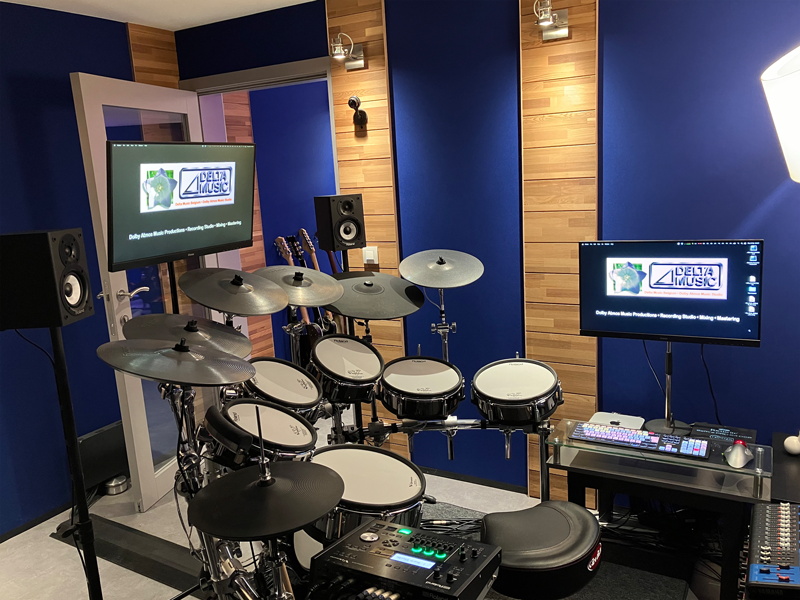
It is perfectly possible to place an acoustic drum kit in the Recording Room, in principle, but the answer is 'no', unless your acoustic drum kit would be of exceptional quality.
In the USA today young people call an acoustic drum kit "grandpas drums" and this has a reason: a contemporary high-end electronic drum kit is not inferior to an acoustic drum kit at all, on the contrary, + it also makes the recording process much easier as you no longer need to use microphones.
To immediately follow this trend, Delta Music Belgium invested in a Roland TD-50KV electronic drum kit.
This drum kit is the top-of-the-line model from the legendary Roland V-Drums Pro Series and is praised for it's realistic playability and unmatched sound quality of the built-in drum sounds + it can also be used as a MIDI drum trigger for software drum samplers. It is possible to simultaneously record in Pro Tools | HDX the sound of one of the many drum kits in the TD-50KV through 10 separate outputs along with the electronic MIDI data generated by the Roland TD-50 drum module. This MIDI data can be assigned to Toontrack - SUPERIOR DRUMMER 3, the flagship of the software drum samplers with many more available drum kits.
Overall, in 95% of cases it is possible to play and record live the perfect drum track for your recordings. If necessary you can correct the recording afterwards, both in terms of performance errors and in terms of the choice of drum sounds. Do you want to know what this drum kit can do, please go to Youtube and perform a search for "Roland TD-50KV with Toontrack - SUPERIOR DRUMMER 3" and you will probably be amazed about what you will see and hear...
The monitoring is done via a Roland CM-220 CUBE Monitor - 2.1 Monitor System for Electronic Instruments. This is a 200 watt subwoofer and two 60 watt sattelite speakers, specially designed for the high dynamic range of electronic musical instruments. It presents a very realistic drum sound in the recording room including a correct stereo imaging. So it is not necessarily required to play the drums with headphones, now it can sound just as loud like a standard drum kit, or, if needed, much much louder .The speakers can also be used to give a bit more power when using headphones (for example just the subwoofer so you can feel the kick). For your information: all extra drum hardware is made by Gibraltar, including a Gibraltar 6611DB Avenger II double bassdrum pedal for heavier rock drumming.
FYI: of course it is also possible to work with audio and / or MIDI drum loops only and create the perfect drum track without touching any drum stick at all
More info about the Roland V-Drums can be found on the dedicated page
![]()
9. Can I order 1000 CDs or 200 vinyl records?
![]()
Delta Music Belgium is no CD pressing plant, so you can't have 1000 CDs made. I can refer you to good CD pressing plants and advice you on how you can deal with this in the best possible manner. Delta Music Belgium is registered with SIMIM so I can create ISRC codes that are both needed for CD pressing as for iTunes
![]()
10. How does Delta Music Belgium deal with your privacy?
![]()
After running a recording studio for many years I have experienced firsthand how imortant privacy is for the majority of my customers. Fans and the tabloid press are constantly on the prowl, it's all in the game, but also the gossip inside the music business is not to be underestimated. I must admit that in my early years I also let myself be drawn into such rumors, sometimes with serious consequences... People making mistakes is inherent to being human, you can only try to learn from it wherever possible.
For clarity, I have drawn up the following list of assurances that I give in the area of the protection of privacy and related topics.
Privacy in the studio
- what happens in the studio is strictly private and is not to be shared with anyone
Photography and filming in the studio
- I will never take photos or videos during studio sessions, unless otherwise agreed with the customer
- customers are not allowed to take photos and videos in the studio, unless after written permission
- photos and videos in which I can be seen are subject to the right to one's own image, only after written permission the customer can be allowed make these public under predetermined conditions
Privacy on the Internet and in the media
- I will never put photos or videos online showing customers, unless in exceptional circumstances at the request of the customer
- I will never publish any texts about customers, unless in exceptional circumstances at the request of the customer
- orally, I will spread as less information about my customers as possible with much restraint, unless it concerns information that is freely and publicly available for everyone
Privacy and copyright
- I follow all legal requirements in the field of copyright and will in no way give my cooperation to the evasion of copyrights, illegal splitting of copyrights or any other crime
- in any way lyrics and music will be distributed without express permission from the author / composer
- it is possible that I show Pro Tools sessions with recordings of customers to other customers or potential customers / visitors , but only for paeronal promotion and/or promoition of the studio and only within the closed environment of the studio
Digital privacy and security
- all files are used and stored on computers and storage devices that are protected with passwords
- the digital network within Delta Music Belgium (LAN and WLAN) is protected against external attacks (hacking) by an extensive firewall protection
- in case of digital delivery of music files I only work with secure servers with 256-bit Advanced Encryption Standard (AES), the transmission between server and client is protected with 128-bit or higher Advanced Encryption Standard (AES)
Legally required privacy statement and cookie policy
- you can find the legally required privacy statement and cookie policy on the Privacy notification and cookie policy, this link is also present at the bottom of every page of this website
![]()
11. What is the name of the flower in the logo of Delta Music Belgium?
![]()
The flower in the logo of Delta Music Belgium is a wild harebell, the Latin name is Campanula rotundifolia. It is a very rare flower in Belgium and therefore protected as endangered plant species. The flower is 1 cm. large and very vulnerable.
The picture below I have taken myself on August 29, 2005 at Fort IV in Mortsel with a Nikon Coolpix 5600, this is the original photo that I've cut the harebell from:


![]()
![]()
Copyright © 1995-2025 by Delta Music Belgium • Dolby Atmos Music Studio • Rummenweg 30 • 3800 Sint-Truiden • Belgium
All Rights Reserved
Privacy notification and cookie policy
All product names, logos, and brands are property of their respective owners.
All company, product and service names used on this website are for identification purposes only.
Use of these names, logos, and brands does not imply endorsement.
![]()


